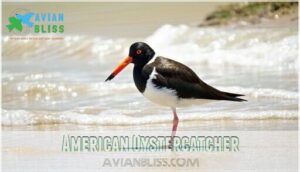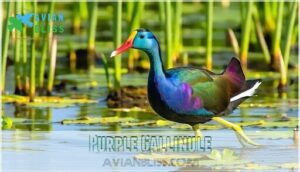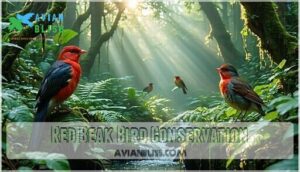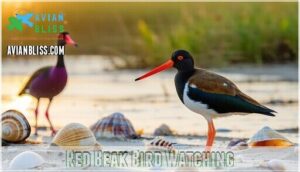This site is supported by our readers. We may earn a commission, at no cost to you, if you purchase through links.
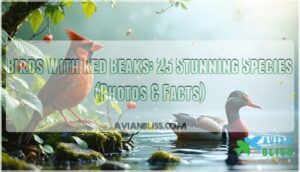
These vibrant bills aren’t just eye-catching—they’re perfectly designed tools. Northern Cardinals crack seeds with their cone-shaped beaks, while American Oystercatchers use theirs like tweezers to pry open shellfish.
The red coloration comes from carotenoids in their diet, the same pigments that make carrots orange. Wood Ducks sport elegant red-orange bills that complement their iridescent plumage, and Purple Gallinules flash bright coral beaks as they wade through wetlands.
Each species has evolved its beak shape and color for specific survival needs, creating nature’s own toolkit with unique adaptations like the cone-shaped beaks.
Table Of Contents
- Key Takeaways
- Red Beak Bird Species
- Geographic Distribution
- Red Beak Functions
- Red Beak Bird Conservation
- Red Beak Bird Watching
- Frequently Asked Questions (FAQs)
- What kind of bird has a red beak?
- Why do birds have red beaks?
- How many birds have red beaks?
- What does a bird’s beak look like?
- Are red beaked birds hard to find?
- Why do hummingbirds have red beaks?
- Do pigeons have red beaks?
- What black bird has a bright red beak?
- What is the name of the bird with a red beak?
- What is a crow-like bird with a red beak?
- Conclusion
Key Takeaways
- You’ll find red-beaked birds in diverse habitats from your backyard to coastal shores, with species like Northern Cardinals, American Oystercatchers, and Purple Gallinules each adapted to specific environments and feeding needs.
- Red beak coloration comes from carotenoids in their diet, and these vibrant bills aren’t just decorative—they’re specialized tools for cracking seeds, prying open shellfish, attracting mates, and signaling health status during breeding season.
- Each species has evolved unique beak shapes for survival, from the cardinal’s cone-shaped seed-cracker to the merganser’s serrated fish-grabber, demonstrating nature’s perfect engineering for specific ecological niches.
- You can help protect these colorful birds through habitat conservation efforts, responsible bird watching practices, and supporting restoration projects, as many red-beaked species face threats from habitat loss, pollution, and climate change.
Red Beak Bird Species
You’ll encounter red-beaked birds in surprisingly diverse habitats, from your backyard Cardinal feeding at the feeder to the powerful Oystercatcher patrolling rocky coastlines with its bright orange-red bill.
From backyard cardinals to coastal oystercatchers, red-beaked birds showcase nature’s brilliant adaptations across every habitat on Earth.
These species showcase remarkable adaptations, with beak colors ranging from the Cardinal’s vibrant orange-red to the Common Merganser’s sleek scarlet bill, each perfectly designed for their specific feeding behaviors and environments, highlighting the importance of specific feeding habits.
Northern Cardinal
You’ll instantly recognize the Northern Cardinal by its brilliant reddish-orange beak and striking plumage variation between males and females.
These North American birds thrive in backyard habitat year-round, making bird identification easy for beginners.
Their distinctive Cardinal Song echoes through neighborhoods, while regional differences in size help with winter survival.
Males sport vibrant red feathers, females show warm brown tones with red accents.
They’re fiercely territorial, especially during breeding season.
Wood Duck
While cardinals charm backyard birders, Wood Duck males showcase nature’s artistry with their partially red bills and rainbow plumage variation.
These North American birds nest in tree cavities near water, where duckling development occurs rapidly.
You’ll spot these red beak birds in wooded swamps and marshes.
Despite habitat loss concerns, their conservation status remains stable through dedicated wetland protection efforts.
Common Merganser
You’ll spot Common Mergansers by their distinctive long, straight red bills – perfect for their fish-focused diet.
These waterfowl excel at diving behavior, plunging underwater to catch prey with serrated bill edges that grip slippery fish.
Merganser identification becomes easier when you notice their sleek profile and diving patterns.
Unlike many red beak birds, they’re specialized fish-hunters facing habitat threats from waterway pollution and development, which affects their overall diving behavior.
American Oystercatcher
Along coastal shores, you’ll spot the American Oystercatcher’s striking appearance among birds with red beaks.
Nature’s coastal artisan, the American Oystercatcher wields its brilliant orange-red bill like a master craftsman opening ocean’s treasures.
This shorebird’s bright orange-red bill perfectly handles its Oystercatcher Diet of shellfish and marine worms.
During bird watching sessions, notice their black-and-white Plumage Variation and listen for their piercing calls.
Their Nesting Habits involve scraping shallow depressions in sand, though Coastal Conservation efforts protect against Predator Threats.
Purple Gallinule
You’ll recognize the Purple Gallinule by its striking red beak tipped with golden yellow, making it one of the most distinctive red beaked species.
This wetland gem showcases incredible plumage iridescence with electric blue and purple feathers that shimmer in sunlight.
Key Purple Gallinule characteristics for bird identification:
- Juvenile markings appear brownish before developing adult colors
- Diet specifics include aquatic plants, insects, and small fish
- Vocalizations feature loud, distinctive "kek-kek-kek" calls
- Nesting behavior involves building platforms above water
- Birds with red beaks like these prefer freshwater marshes
Geographic Distribution
You’ll find red-beaked birds scattered across nearly every habitat on Earth, from bustling city parks and quiet suburban backyards to remote mountain meadows and windswept coastal shores.
These colorful species have adapted to environments ranging from Arctic tundra to tropical wetlands, with some migrating thousands of miles seasonally while others stick close to home year-round, exhibiting a wide range of behaviors in their respective natural habitats, and showcasing their ability to thrive in various environments.
Coastal Regions
Coastal regions showcase incredible diversity among birds with red beaks. You’ll find American Oystercatchers cracking shells along rocky shores, while Black Skimmers glide across calm waters with their unique bills. Laughing Gulls patrol beaches during breeding season, their bills turning deep red.
| Species | Coastal Habitat Preference |
|---|---|
| American Oystercatcher | Rocky shores and mudflats |
| Black Skimmer | Calm bays and lagoons |
| Laughing Gull | Sandy beaches and harbors |
| Caspian Tern | Open coastlines and estuaries |
| Common Tern | Protected coastal waters |
These bird coasts face challenges from Coastal Habitat Loss, making Saltwater Birding Spots increasingly precious. Red Beak Adaptations help these species thrive in harsh saltwater environments, with specialized Coastal Bird Diets ranging from shellfish to small fish.
Coastal Conservation efforts protect these remarkable creatures and their disappearing habitats.
Freshwater Habitats
Several birds with red beaks thrive in freshwater environments, making lake diversity and river birds a birdwatcher’s dream.
You’ll find Purple Gallinules in marsh habitats and Common Mergansers diving in deeper waters.
These waterfowl have adapted their bird diet and feeding habits perfectly to swamp ecosystems, where wetland conservation efforts help protect their essential bird habitats.
The availability of food sources for birds is essential for maintaining these populations.
Urban Areas
When you’re exploring city neighborhoods, you’ll spot birds with red beaks adapting remarkably well to urban environments.
Northern Cardinals frequent City Bird Feeds, while Common Gallinules visit Urban Bird Baths in parks.
However, Habitat Loss, Light Pollution, and Noise Pollution challenge these species.
Your bird identification guide becomes essential for bird watching amid increasing bird human interaction in these transformed bird habitats.
High-Altitude Grasslands
Soaring through thin mountain air, birds with red beaks demonstrate remarkable alpine adaptations in high-altitude grasslands.
You’ll find these hardy bird species thriving where oxygen runs scarce and temperatures plummet.
Their specialized bird adaptation allows successful avian distribution across challenging terrain.
Grassland ecology supports diverse bird habitats, though climate impacts and conservation challenges threaten these resilient populations requiring careful bird beak identification for protection efforts.
Red Beak Functions
You’ll discover that red beaks aren’t just for show—they’re specialized tools that help birds crack seeds, spear fish, probe mud for worms, and even attract mates during breeding season.
Each beak shape tells a story about how these birds survive, from the thick, crushing bill of a cardinal to the needle-like probe of a hummingbird designed for nectar feeding.
Foraging Techniques
Mastery defines how red-beaked birds tackle their daily hunt for survival.
You’ll witness fascinating bird behavior as these species employ diverse strategies to secure meals, showcasing remarkable bird adaptations that’ve evolved over millennia.
- Prey detection methods range from visual scanning to sensing vibrations in water or soil
- Cooperative hunting occurs when species like terns work together to corral fish schools
- Tool use appears in some species that manipulate objects to access hidden food sources
- Diet variations shift based on seasonal availability and environmental conditions
- Seasonal foraging patterns change dramatically as bird dietary preferences adapt to migration cycles
Beak Shapes and Functions
You’ll notice that bird bills reveal nature’s engineering brilliance through their diverse shapes and specialized functions.
Beak morphology directly reflects feeding adaptations – from the cardinal’s seed-cracking cone to the merganser’s serrated fish-grabbing design.
Bill strength varies dramatically based on diet, while sensory perception enhances hunting accuracy.
Birds with red beaks showcase remarkable anatomical diversity, with each species’ bill perfectly adapted for their ecological niche and preening behavior requirements.
Providing birds with varied wooden perches helps maintain beak health and supports their overall well-being in a natural way, reflecting their ecological niche.
Specialized Diets
Birds with red beaks showcase remarkable dietary adaptations that’ll surprise you.
Their nutritional needs drive seasonal diets – cardinals crack seeds year-round while terns switch to fish during breeding.
These specialized feeders have evolved distinct foraging behaviors, from mergansers crushing fish with serrated bills to oystercatchers prying open shellfish.
Each red-beaked species demonstrates unique prey specialization through perfectly adapted bird feeding strategies, highlighting their remarkable adaptations.
Mating and Reproduction
Attraction plays a vital role when red beaks signal breeding readiness during courtship rituals.
You’ll notice these vibrant bills become brighter during breeding season, helping birds find suitable mates through sexual selection.
Bird mating involves elaborate displays where males showcase their colorful beaks.
Nesting habits vary by species, but parental care remains consistent—both parents feed developing chicks until they’re independent.
Red Beak Bird Conservation
You can help protect red-beaked birds by supporting habitat restoration projects and choosing bird-friendly products, since many species face threats from pollution, climate change, and habitat loss.
Scientists work with conservation groups to monitor populations and create protected areas, but these colorful birds need your everyday actions to thrive in an increasingly challenging world, which is affected by climate change.
Threatened Species
Several red beaked species face mounting pressures from habitat loss and climate change.
You’ll find that invasive species particularly threaten 39% of vulnerable birds with red bills.
Pollution impact compounds these challenges, making bird conservation status increasingly precarious.
Agricultural expansion is the leading threat, impacting 74% of vulnerable bird species.
However, targeted conservation strategies have successfully prevented 21-32 extinctions since 1993, proving that dedicated bird conservation efforts can turn the tide for endangered species with conservation efforts and conservation status.
Endangered Species
Among birds red bills species, several face critical endangered species status due to habitat loss and climate change.
Population decline threatens red beaked species’ genetic diversity worldwide. You’ll find conservation status particularly alarming for hornbills, where Southeast Asian populations have crashed since 2012.
The surge in poaching is driven by the demand for red ivory. Bird conservation efforts must address these urgent threats before we lose these remarkable species forever, which would be a loss of genetic diversity and remarkable species.
Conservation Efforts
You can make a real difference through targeted bird conservation efforts that protect red-beaked species.
Habitat Preservation programs restore wetlands and forests, while Breeding Programs boost vulnerable populations.
Public Awareness campaigns educate communities about Pollution Impact and Climate Change threats.
These bird conservation initiatives rely on your support—whether volunteering, donating, or simply spreading the word about bird protection needs.
Human Impact
Human activities directly threaten red-beaked birds through habitat loss from development and agriculture.
Pollution effects contaminate their food sources, while climate change alters migration patterns and breeding cycles.
You can support bird conservation efforts by participating in ecotourism impact programs and backing bird habitat conservation initiatives.
Understanding bird human interactions helps address conservation concerns and monitor bird population trends effectively.
Red Beak Bird Watching
You’ll find red-beaked birds in diverse habitats, from coastal shores where American Oystercatchers probe for shellfish to freshwater marshes where Purple Gallinules wade through vegetation.
Success in spotting these vibrant species requires patience, proper timing during breeding seasons when beak colors are most intense, and knowledge of each bird’s preferred feeding times and locations.
Best Locations
You’ll find red-beaked birds across diverse habitats worldwide.
Coastal hotspots like Florida’s Everglades and California’s beaches offer American Oystercatchers and terns.
Wetland wonders such as Louisiana marshes attract Purple Gallinules and Common Moorhens.
Urban sightings of Northern Cardinals happen in city parks and suburban backyards.
Migration routes along major flyways provide seasonal opportunities to spot these colorful species during their travels.
For birding enthusiasts, exploring Virginia’s avian diversity can reveal a wide array of species.
Photography Tips
Capturing birds with crimson beaks requires patience and proper technique. Your camera settings matter as much as timing when photographing these scarlet-beaked beauties during golden hour.
Essential Bird Photography Tips:
- Lighting techniques – Shoot during early morning or late afternoon when soft light enhances red beak colors naturally
- Composition rules – Use the rule of thirds, placing birds off-center for dynamic shots
- Equipment choices – Select telephoto lenses (300mm+) to maintain respectful distances from subjects
- Bird behavior – Study feeding patterns and perching habits to anticipate perfect moments
Consider where to find necessary photography equipment before heading out.
Ethical Guidelines
Responsible observation means keeping your distance—don’t stress birds for that perfect shot.
Respectful photography protects nesting sites and feeding areas.
Support bird conservation strategies through informed advocacy and conservation funding.
Follow habitat protection guidelines by staying on designated trails.
Your bird watching choices directly impact bird conservation concerns, so practice bird protection measures that prioritize wildlife welfare over personal convenience.
To guarantee ethical practices, consider bird watching products that promote responsible observation.
Cultural Significance
Red-beaked birds carry deep symbolism across cultures, appearing in folklore and mythology as divine messengers.
You’ll discover these species featured prominently in art and literature, representing power and spiritual communication.
Many societies view them as bird status symbols, with their vibrant beaks signifying mate attraction and social rank, enriching cultural traditions through their bird heritage, connecting communities to nature’s wisdom through centuries-old bird culture.
Frequently Asked Questions (FAQs)
What kind of bird has a red beak?
Several bird species sport vibrant red beaks that’ll catch your eye.
You’ll spot Northern Cardinals, Wood Ducks, and American Oystercatchers flashing their crimson bills, while hummingbirds like the Broad-billed variety showcase stunning coral-colored beaks.
Why do birds have red beaks?
While you might think red beaks are just for show, they actually serve essential survival functions.
You’ll find these vibrant bills help birds attract mates, establish dominance, and signal their health status to potential partners.
How many birds have red beaks?
Hundreds of bird species worldwide sport red beaks, from tiny hummingbirds to massive pelicans.
You’ll find them across every continent except Antarctica, with colors ranging from bright crimson to deep coral shades.
What does a bird’s beak look like?
A beak’s like nature’s Swiss Army knife—you’ll see razor-sharp daggers, tiny tweezers, massive nutcrackers, and delicate straws.
Each species sports a perfectly engineered tool that matches their dining habits and lifestyle needs, making the beak a versatile instrument akin to a Swiss Army knife.
Are red beaked birds hard to find?
You’ll spot them easier than you’d think! Many red-beaked species like cardinals, woodpeckers, and hummingbirds frequent backyards and parks. They’re actually quite common once you know where to look.
Why do hummingbirds have red beaks?
Ironically, these tiny aerial acrobats don’t need red beaks for flight—you’ll find their crimson bills help attract mates and establish territory.
The vibrant coloration signals health and genetic fitness to potential partners during breeding season.
Do pigeons have red beaks?
Pigeons don’t have red beaks – you’ll typically see orange, pink, or grayish bills on these common city birds.
Their beaks lack the bright red coloration found in cardinals, woodpeckers, and other red-beaked species.
What black bird has a bright red beak?
Ever wondered which dark-feathered bird sports nature’s most striking crimson bill?
You’ll find the Black Oystercatcher along rocky Pacific shores, where its brilliant red beak contrasts beautifully against jet-black plumage and coastal waves, showcasing its distinctive plumage.
What is the name of the bird with a red beak?
You’ll find several birds sporting red beaks, including the Northern Cardinal with its vibrant orange-red bill, the American Oystercatcher’s thick bright red beak, and the Purple Gallinule’s red-and-yellow-tipped bill.
What is a crow-like bird with a red beak?
Like a shadow with a crimson dagger, you’re looking at the Chough.
This sleek black bird sports a brilliant red beak and matching feet, making it stand out among its corvid cousins across European grasslands.
Conclusion
Nature’s red-billed ambassadors paint landscapes worldwide with their brilliant beaks, each telling a unique evolutionary story.
Birds with red beaks showcase remarkable diversity, from seed-cracking cardinals in your backyard to shellfish-hunting oystercatchers along coastlines.
You’ve discovered how carotenoids create these vibrant colors while specialized shapes serve distinct survival functions.
Whether you’re photographing wood ducks or observing purple gallinules, these species remind us that conservation efforts protect both individual beauty and ecosystem balance for future generations.
- https://www.researchgate.net/publication/372242480_Beak_shape_and_nest_material_use_in_birds
- https://ftp.104homestead.com/virtual-library/b537QI/9956489/birdsandbeakslab.pdf
- https://arxiv.org/html/2312.14999v3
- https://www.ok.org.br/fetch.php/wp4F97/4411277/northamericanbirdidentificationdichotomouskey.pdf
- https://jcbi.org/index.php/Main/article/download/277/196/958


